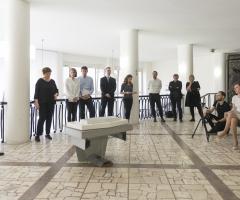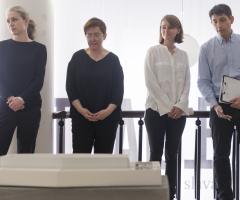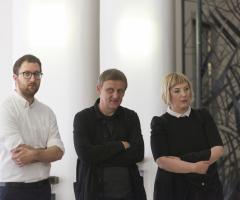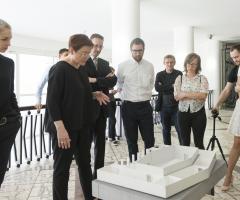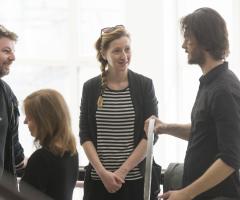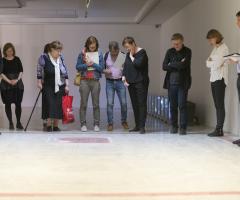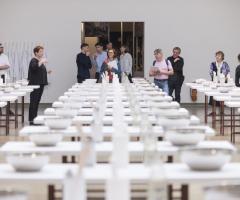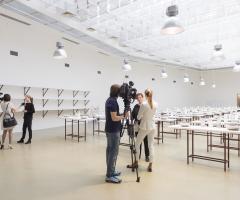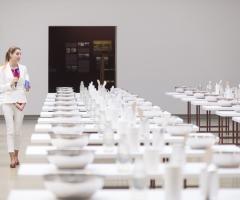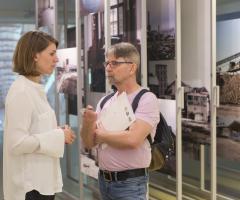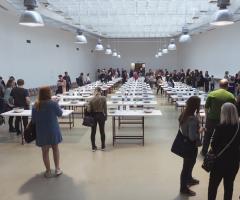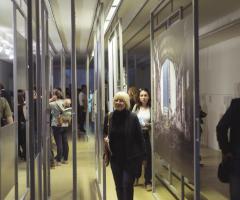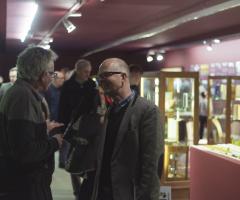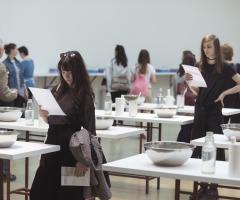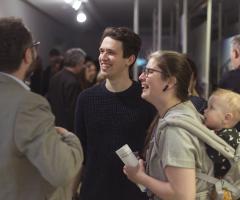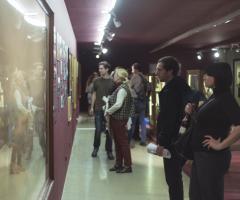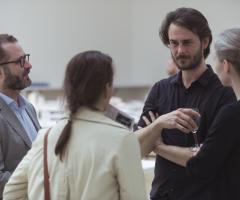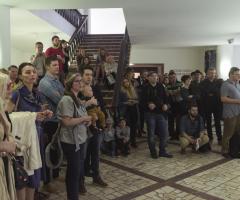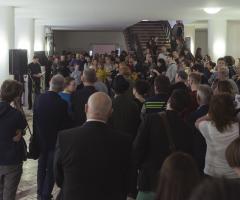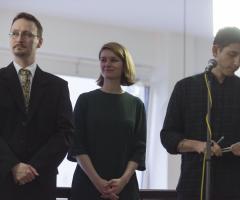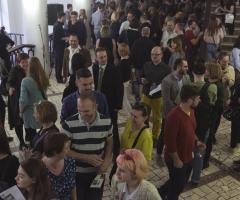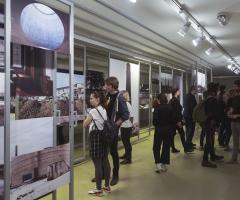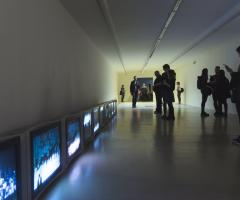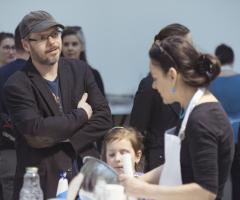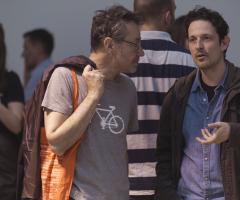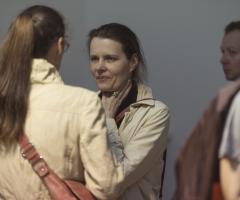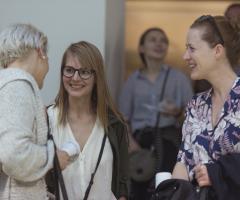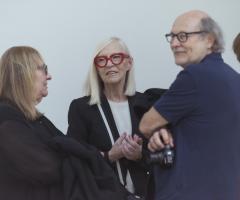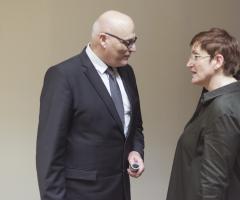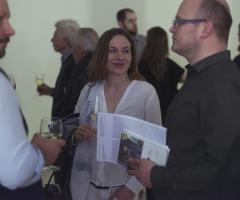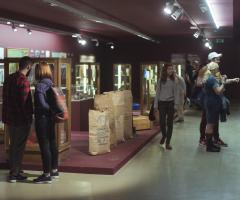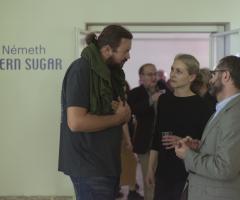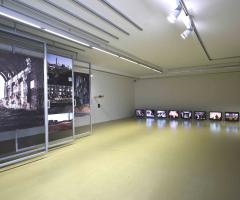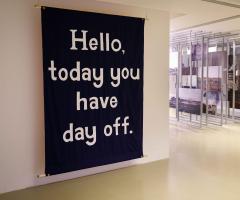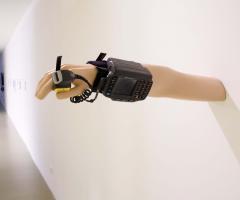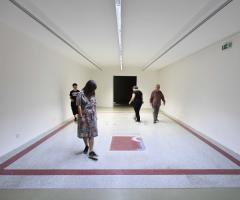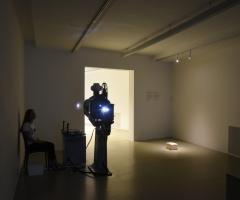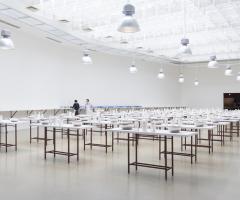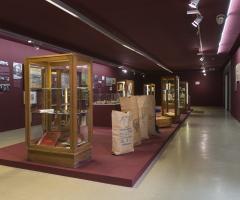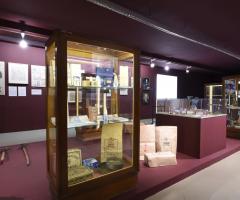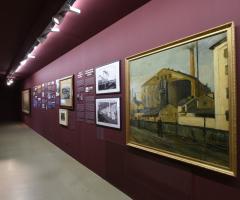ILONA NÉMETH: Eastern sugar
1st floor of KHB
Exhibition view // Photo © archive of KHB / Ema Lančaričová
Opening:
April 12th 2018
from 6 p.m. until 8 p.m.
Duration:
April 13th 2018– July 15th 2018
Venue:
1st floor of KHB
Eastern Sugar: Reconstruction of Reality in Time
- - -
Guests: Jeremy Deller, Harun Farocki, Lonnie van Brummelen & Siebren de Haan
Invited project: Museum of Sugar / Curator: Miroslav Eliáš
Architects: PLURAL, Marián Ravasz
- - -
When we first began thinking about this exhibition and discussing it with the artist, a dilemma arose about how her most extensive and probably also most important art presentation should be constructed. A number of options presented themselves. There were models of exhibitions which would evaluate her visual career in the form of a retrospective and set her in a broader (Central) European artistic context. Alternatively, her exhibition might reflect the phenomena of art as it is currently, with an emphasis on its socio-political potential. In La Biennale di Venezia 2017, then in progress, the award for best national entry went to the German artist Anne Imhof for her radical redefinition of the architecture of the pavilion as a mental-performative space.
Another factor which determined the nature of the current exhibition was our awareness that a retrospective would have been premature for this artist. Furthermore, it would not have been altogether adequate in terms of the gallery space and its context. We were agreed in thinking that contemporary art and its institutions (especially in the state sector) are bearers of social responsibility. All the more so at the present time, when citizens in Slovakia and elsewhere are going out on the streets in recurrent mass protests, which are probably larger even than in 1989, fighting for the return of values to public life, for decency and uprightness, in the firm conviction that the state is not private property and that public affairs matter.
Needless to say, at that time we had no premonition of what was to happen in our society, politics and culture. But this public concern has been a long-term programme in the work of Ilona Németh – a lasting engagement, where the aim is to make society and culture reflect earnestly upon themselves. Practically throughout the entire breadth of her visual production, this artist has thought critically about current socio-cultural and socio-political phenomena which mirror society’s values and at the same time those of the contemporary individual. Her works, exhibitions and projects typically carry a report and an appeal, about who we are, what we have been, what we could be, what forms us, how we ourselves form our environment and reflect on our own history.
Németh does not lay any general theses before us, though her works and exhibitions imply them. Her starting point is often particular, local and personal. However, she visualises personal space and history in a civic sense, as a component of the public territory or a base within it. These spheres are interconnected in her thought and art. The present exhibition Eastern Sugar is likewise based on her personal experience and knowledge, which forcefully resonates as an echo of our social situation: the “selling off” of our own values. She turns to the powerful but somehow scarcely visible story of the sugar factories in Slovakia, originally state-owned and prospering, gradually privatised and tunnelled, today irrevocably destroyed.
Eastern Sugar was the name assigned to the largest Slovak sugar factory Juhocukor (“Southern Sugar”), situated in Dunajská Streda, following the accession of a foreign majority shareholder in 1993. Redesigned in this fashion (there were promises of investment, revitalisation, international connections and an overall flourishing of sugar production in Slovakia), the factory survived only until 2007. Then its definitive closure was announced, production ceased, and the need to compensate for lost supply with imports was acknowledged. This borrowing (matter-of-fact, somewhat laconic) of the name of a privatised firm with a revelatory end functions here as pars pro toto: the short-lived fate of the Dunajská Streda sugar factory after privatisation represents only one example of many.
The exhibition’s name carries an apt, if partly ironic and critical, linguistic metaphor, in that “our – domestic – Slovak” was transformed by sale into “alien – external – foreign” and thus in actual fact expired, ceased to exist. The reference here is not only to the massive privatisation processes in the 1990s under Mečiar and again in the early years of the new millennium, but also to a certain form of dispossession of the state vis-à-vis the citizens and society. De facto this resulted in a harsh confiscation of work, life-background, relationships, and the values associated with them, in the name of the financial profit of so-called investors. It speaks for itself that the Dunajská Streda sugar factory had been established in the 1960s, and many of the others in our country had been founded before World War I.
Németh’s focus on the history and actuality of sugar factories in Slovakia is exceptionally humane and socially involved. The exhibition reconstructs memory through the fundamental human activity which is work. In the central hall of the gallery the artist evokes the manufacturing space itself. She builds a spacious installation in an austere food-processing design, which is intended not only for manual work but also for mental participation (layers of remembrance, empathy, identification, and so on). She draws in not only people who have this personal history and experience but ordinary viewers also, involving them in the manufacture of sugar loaves, which can be manufactured personally by hand and taken away as a kind of memorial object or “artefact”. Furthermore, she makes contact with workers through the Employment Office and offers them contractual conditions, with a real opportunity for making their presence felt.
Manufacture, in the sense of “an open workshop”, is conceived as a participative installation. It gives presence to the past and activates the manufacturing process and the work which thousands of employees of the defunct sugar factories have lost. To suit the functions and expressive construction of this segment of the exhibition, the architecture of the space has been substantially adapted. Hence the original disposition of the gallery is reordered, and even then, its new perception is further re-evaluated. This is the first time ever that such a radical adaptation of the space has been undertaken in the interests of a unique, site-specific exhibition project, which thus becomes absolutely non-transferable. The architectural studio Plural made a considerable contribution to the artistic modification of the space.
The central hall, representing the lost past, is factually and significantly opened up and expanded into the surrounding space of the gallery’s walkway, which contrastingly offers a view of the present state of the sugar factories in various media. The artist grasps time in its present-ness and achieves this with an interactive adjustable archive of the museum type. In its layers, which may be symbolically “drawn from memory”, she has installed contemporary photographic “portraits” of almost all of the factories in our country (or rather, their skeletons). On this part of the exhibition Németh collaborated with Olja Triaška Stefanović, a visual artist and photographer of architecture whom she involved in the research on particular places, and also with the architect Marián Ravasz.
While the core of the exhibition activates history via temporary work and participation, the present situation and the sad state of the sugar factories today becomes a subject of research and archiving, hence paradoxically of methods for acquiring knowledge and preserving memory. Roles are reversed in the artist’s reconstruction or renovation of reality in time. Apart from the archive, Németh also employs the tools of oral history and enriches the context with several video documentaries. Particularly important sources of information are the interviews with Dušan Janíček, director for external relations of the sugar factory in Sereď, one of the remaining two which are still operational to this day, and Christian Laur, a former member of the Managing board of Eastern Sugar. A suggestive visual essay introduces the video collection, using a drone to map the architecture and exterior of the sugar factory in Pohronský Ruskov. Martina Slováková and Cukru production collaborated on the creation of the videos.
In the wider context of her work the artist is undoubtedly interested in the original linoleum floor (as a readymade) of the entrance hall of the Juhocukor sugar factory in Dunajská Streda. This found object formally connects with Németh’s numerous series of floor works, and in the exhibition context it graduates the moment of identification and memorisation. Purely in itself, in its authentic form and structure, it functions as paradoxical archival records with all the sediment of the past. Within the gallery space the viewer is forced to traverse a linoleum object, upon which they will leave their trace, and this installation neatly connects to a 12-channel video installation by the German film-maker Harun Farocki, Workers Leaving the Factory in 11 Decades, which focuses on the changing cinematic appearance and perception of factory workers.
The exhibition also includes works by the British artist Jeremy Deller, and the Dutch duo Lonnie van Brummelen & Siebren de Haan; artistic practices which broaden the scope of reflection in contemporary art on the theme of work; there is particular reference to the post-industrial condition and to (neo-)colonial trade-relations between the EU and other parts of the world. The art historian and curator Krisztina Hunya has made a valuable contribution by selecting them and connecting them with the exhibition concept, thus providing a comparison of the theme in different geopolitical frameworks. Apart from these guest exhibits, it is gratifying that Németh’s exhibition as a whole is a new work, made to measure for the gallery, which is consciously omitting presentation of her older works.
The artist is partly taking on the role of curator, and within the frame of her own project she is initiating the pilot presentation of a currently non-existent institution, the Museum of Sugar. She has therefore invited the Šurany Municipal Museum, which specialises in the history of sugar processing in Slovakia, to take over part of the exhibition space and for the first time present its materials in the rounded form of a museum display. The Museum of Sugar thus represents a guest “project within a project” which extends opportunities for knowledge and thinking on the theme, with the expertise of museology and museum-style presentation.
This exhibition offers a complex, layered view of the fate of one segment of the food processing industry, spreading out to the wider contexts of the recent history of Europe. The story of the sugar factories is crucially linked with the phenomenon of work and the values which we lost when we sold out, literally. It is a critique of the social attitude to a certain thing and a pointer to the consequences of our decisions, which are suggestively present in the torsos of factories, those absurd relics of the “wild” times of capitalisation and privatisation lived in the spirit of the vacuous slogan “that’s life!”. Németh’s ambition is to offer authentic and critical knowledge, the only thing that may lead to a transformation of values and a willingness to learn from the errors we have committed.
From the artistic standpoint, the exhibition radically restructures the physical space of the gallery and together with that, the mental and memorial layers of the theme. In parallel, it offers viewers several tracks for critical reflection to serve as paths to knowledge, where work or manual activity, an apparently ordinary walkway or an informed awareness, mediated either in the form of oral history or of museum exhibits, may be instruments of empathy. Ultimately, the artist’s powerful social engagement is attested to not only by the participative dimension of the exhibition as such but even by its very method of preparation and realisation, an example of collective creative work only sporadically seen in our milieu.
Nina Vrbanová
Exhibition curator
- - - - - -
ILONA NÉMETH (*1963, Dunajská Streda) is an artist, organizer and curator based in Slovakia. She exhibited widely both locally and internationally, including Karlín Studios, Prague (solo, 2017); Galéria Miloša Alexandra Bazovského, Trenčíne, (solo, 2017); Zachęta – National Gallery of Art, Warsaw (2016); Mestna galerija, Ljubljana (2015); Kunsthalle, Bratislava (2016, 2014); Tranzit Gallery Bratislava (solo, 2014); Museum of Contemporary Art, Bucharest (2013); East – Slovakian Gallery, Košice (solo, 2012); Dum Umenie, Brno (solo, 2012); Ernst Museum, Budapest (solo, 2011), MUMOK, Vienna (2009), Prague Biennale (2005, 2007, 2011); as well as in the Pavilion of the Czech and Slovak Republic at the Venice Biennial (with Jiří Surůvka, 2001), among numerous others. She co-curated the exhibition series Universal Hospitality at the City Festival of Wiener Festwochen (2016), MeetFactory and FUTURA, Prague (2017); and The Private Nationalism Project, travelling to Budapest, Bratislava, Krakow, Dresden, Pécs, Kosice and Prague (2015). She is a professor at the Academy of Fine Arts and Design in Bratislava, leading Studio IN and an international education program Open Studio at the Department of Intermedia – AFAD Bratislava. Her works are represented in various collections including the Ludwig Museum Budapest, National Centre for Contemporary Art, Moscow; Linea Collection, Bratislava; The First Slovak Investment Group’s Collection (PSIS), Bratislava; Bratislava City Gallery; Slovak National Gallery, Bratislava; among many others.
- - - - - -
NINA VRBANOVÁ (*1986, Bojnice, Slovakia) is curator and contemporary art critic. She graduated from the Institute of Literary and Artistic Communication at Constantine the Philosopher University in Nitra and the Faculty of Philosophy of Charles University in Prague. Between 2009 and 2013, she worked as a project manager and curator for the Cyprián Majerník Gallery in Bratislava. Until 2014, she worked as editor of Rider – Print of The Contemporary Art Movement Wall Gazzete. She is a member of the Slovak Section of the International Association of Critics AICA. Since 2014, she has worked in Kunsthalle Bratislava as curator, and currently as its appointed director / chief curator. Between 2010 and 2016, she completed her PhD in aesthetics at the Faculty of Philosophy at Constantine the Philosopher University in Nitra (the theme of her dissertation thesis was “Public Privacy. Semiotic of Visual Phenomena”). She is primarily engaged in developing concepts, in the implementation of curatorial exhibitions as well as in the critical reflection of current trends in visual arts (not only) in Slovakia. Occasionally she publishes in domestic and international professional periodicals and writes reviews on diploma and dissertation theses of artists. She is the founding director of Kunsthalle Bratislava as an independent state-contributory organization of the Ministry of Culture of the Slovak Republic.
- - - - -
- - - - -
European grant Creative Europe


